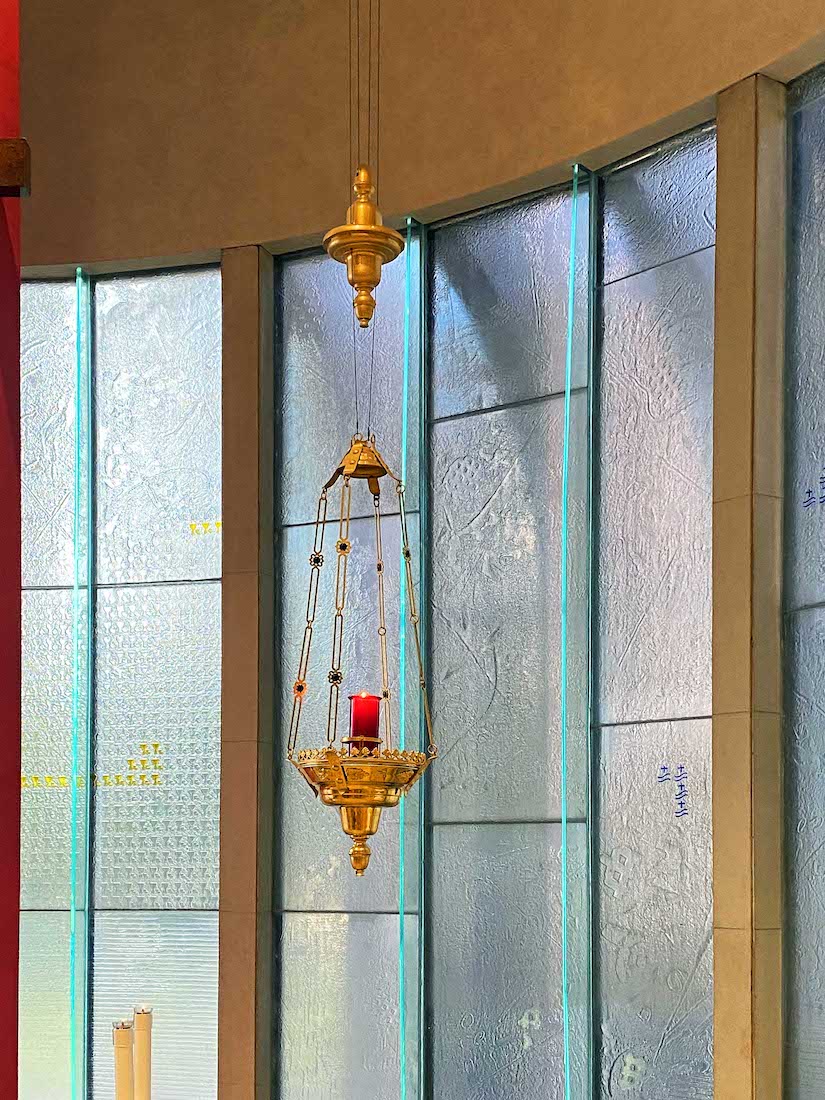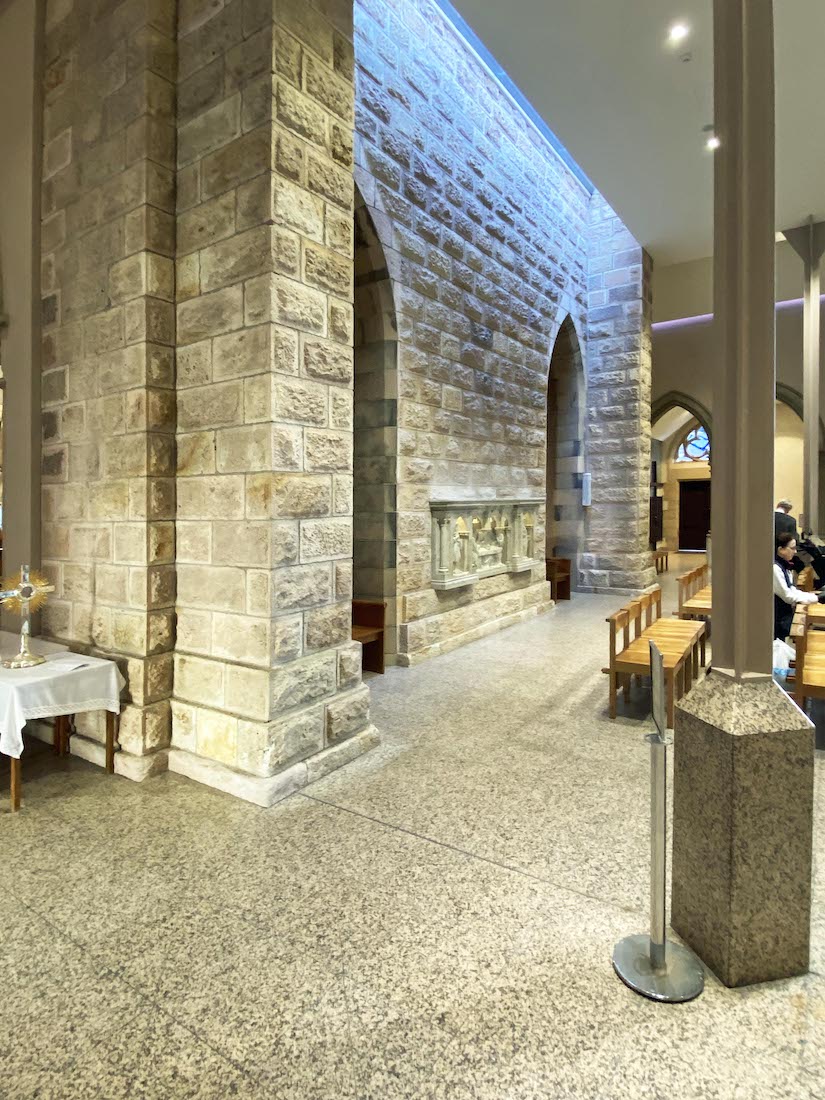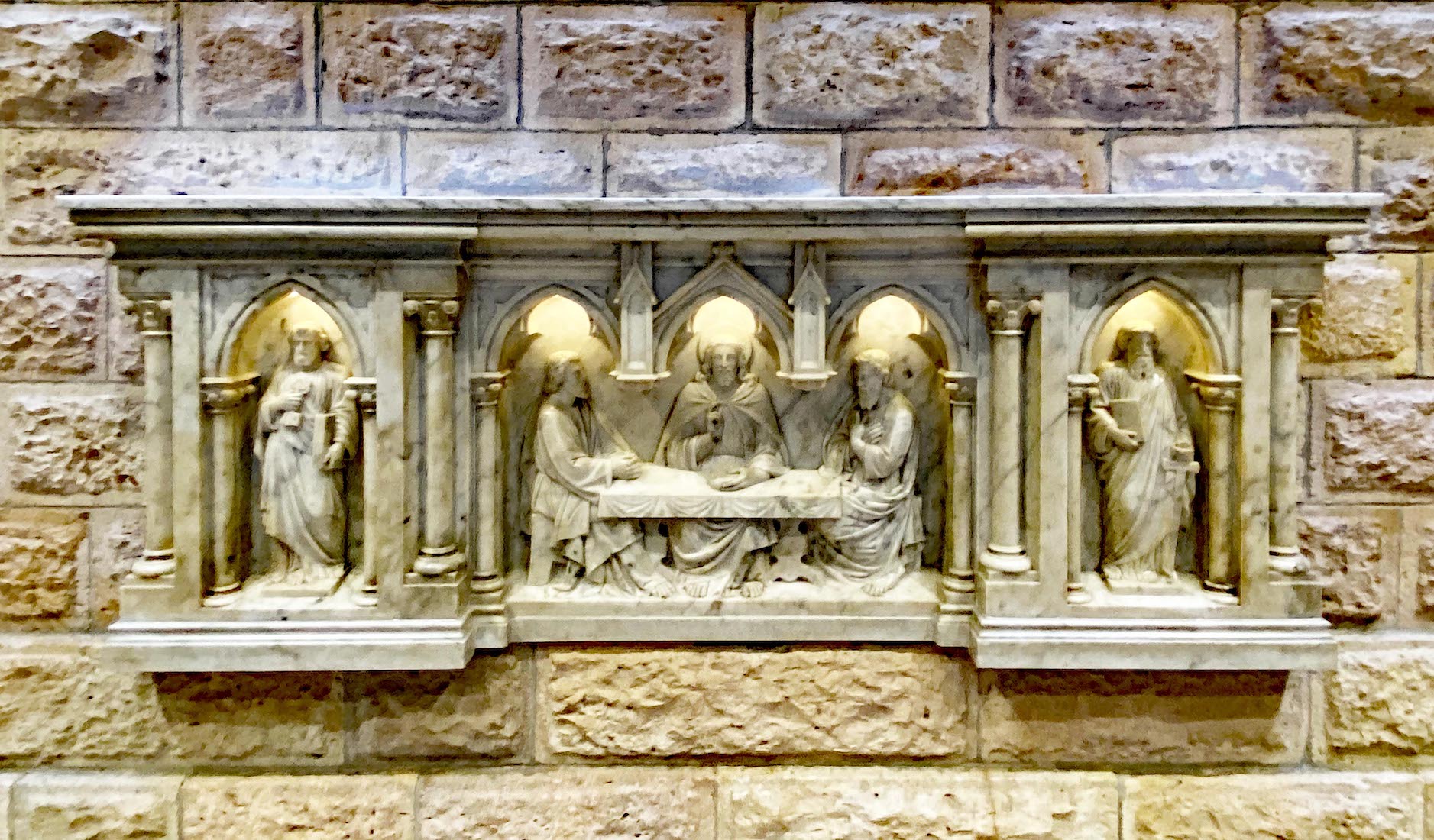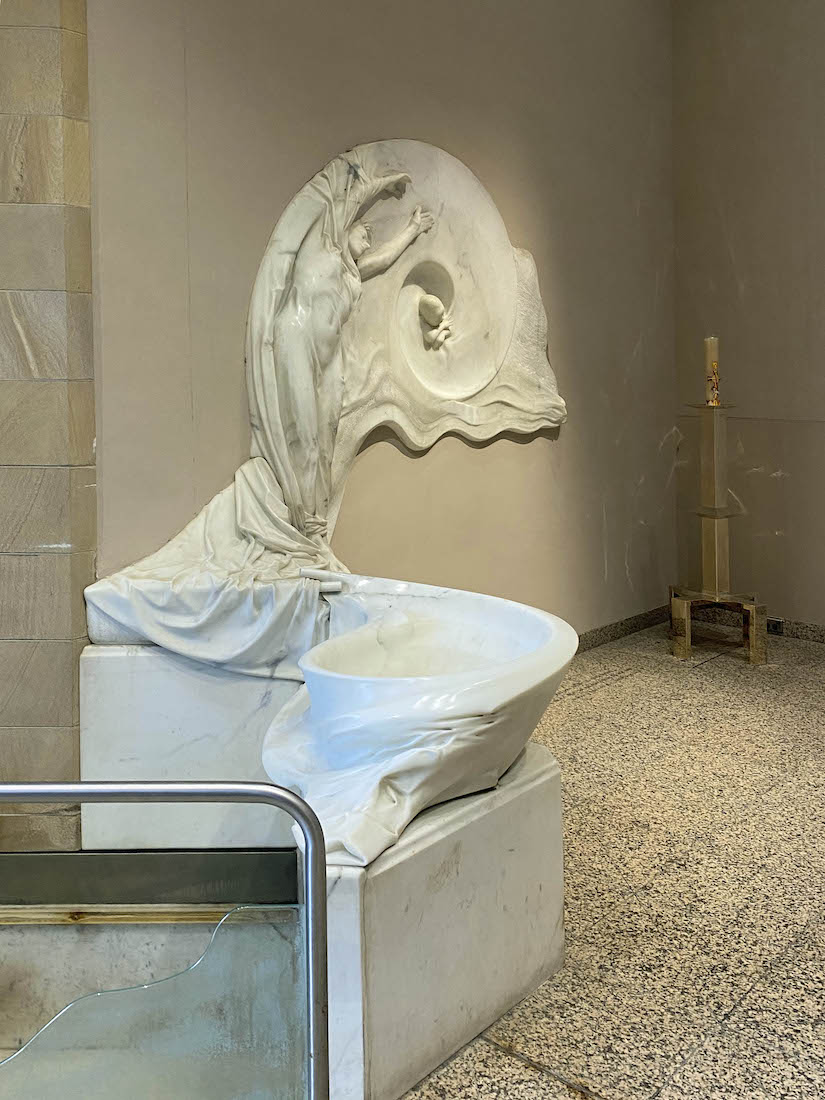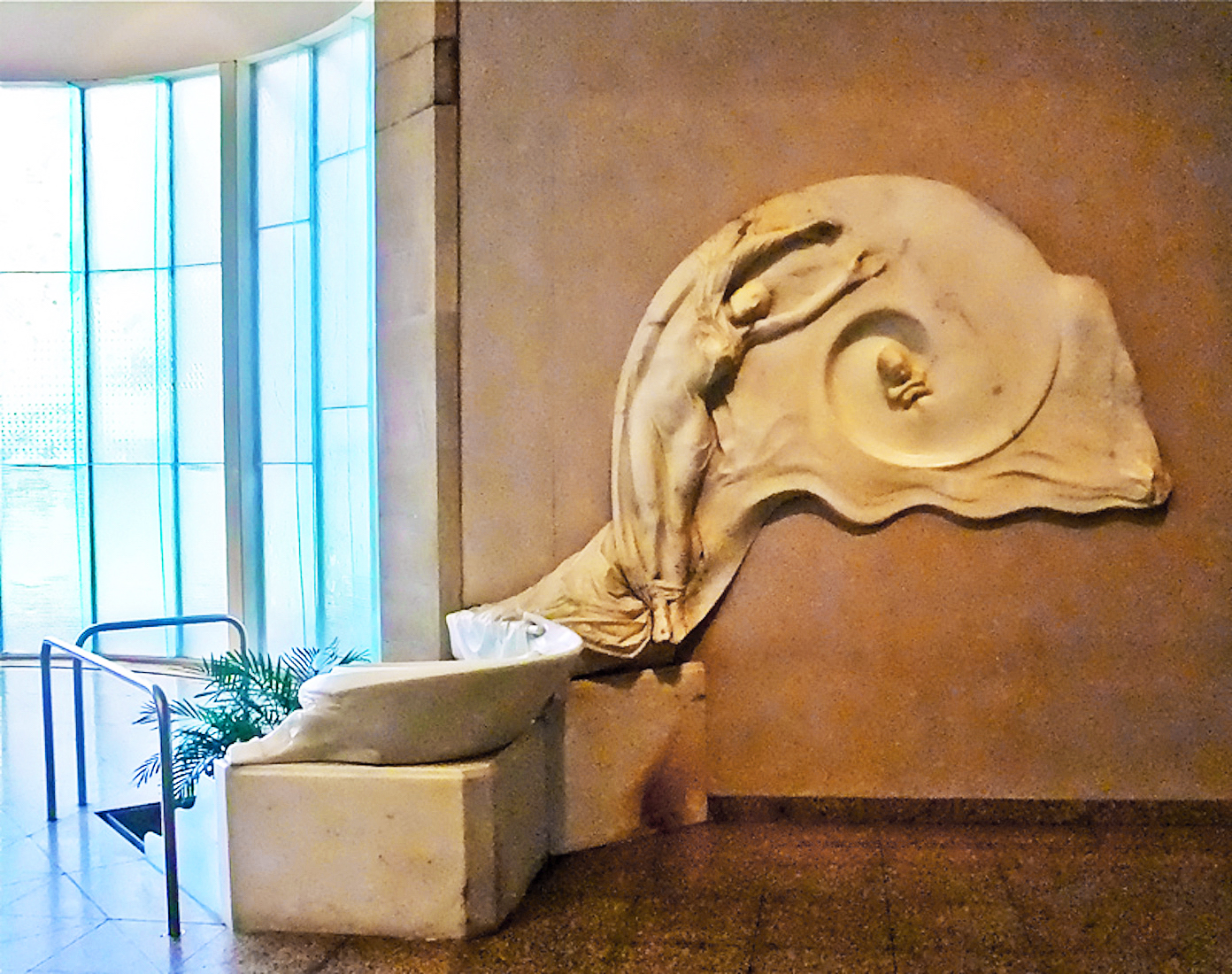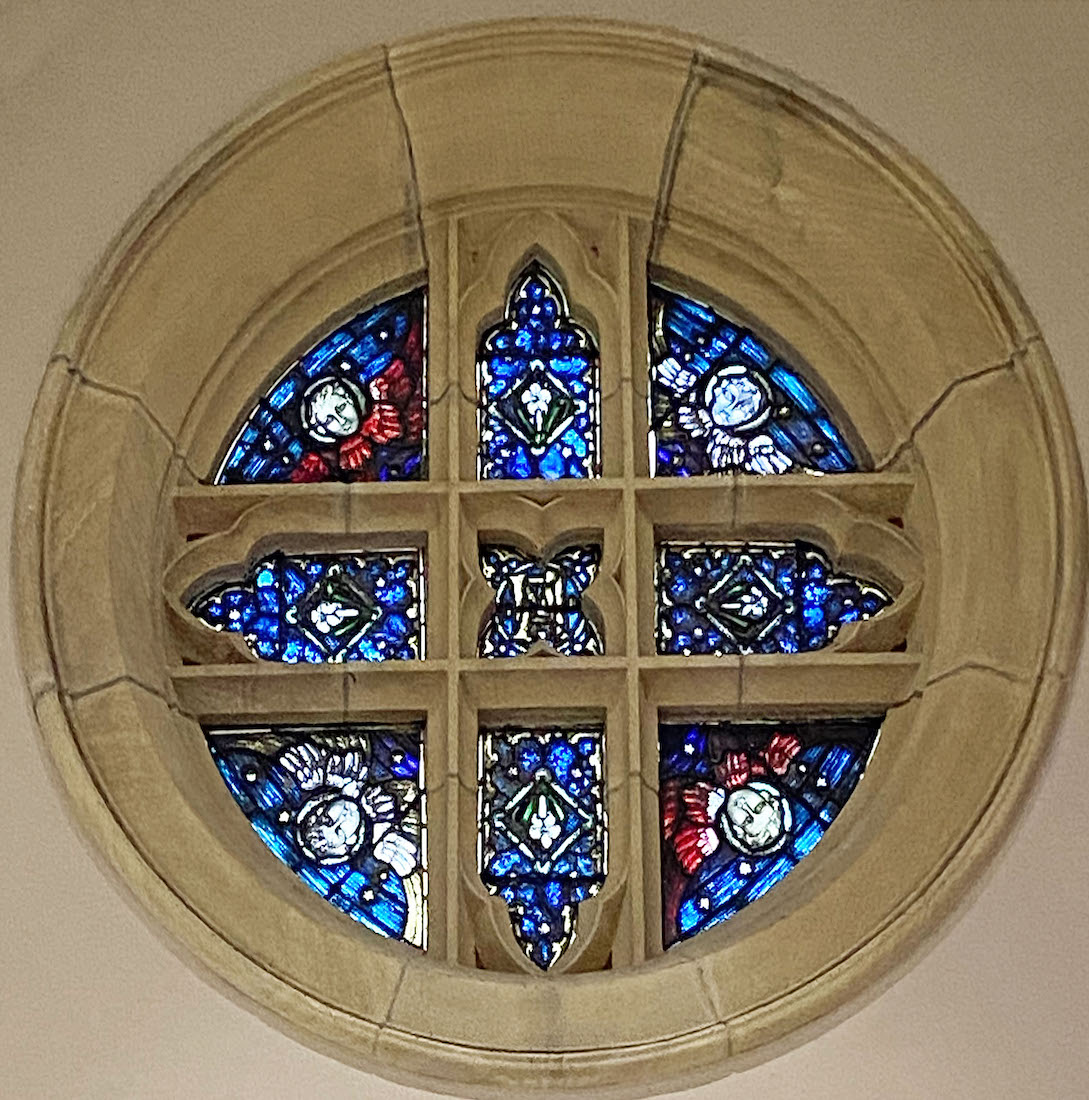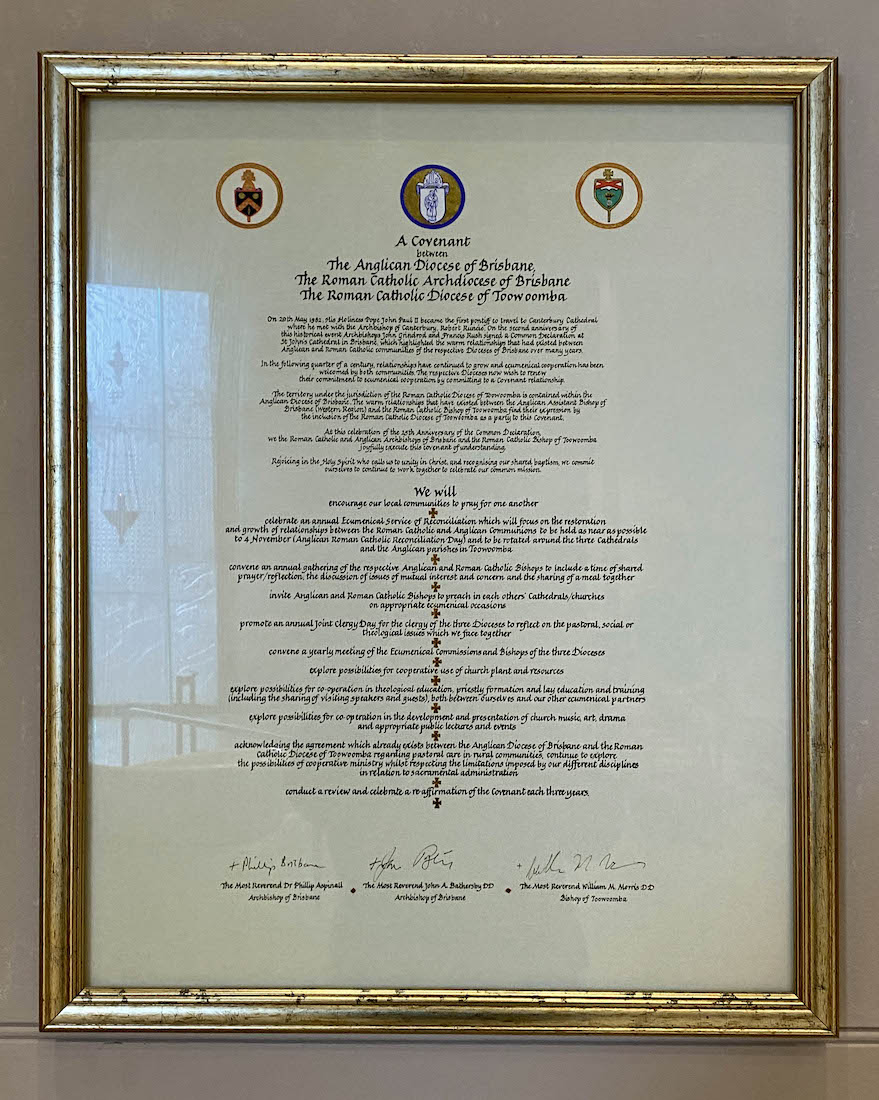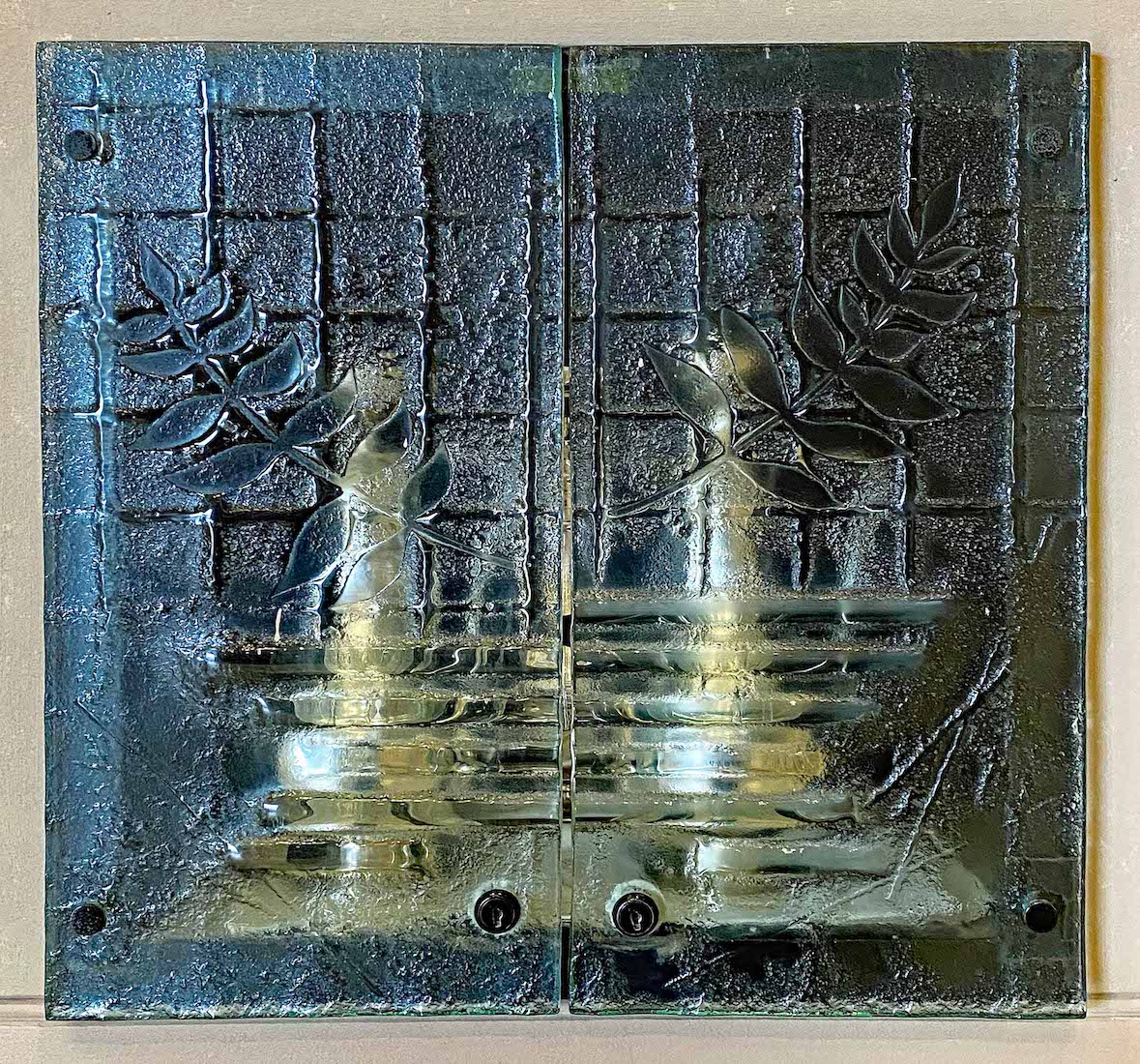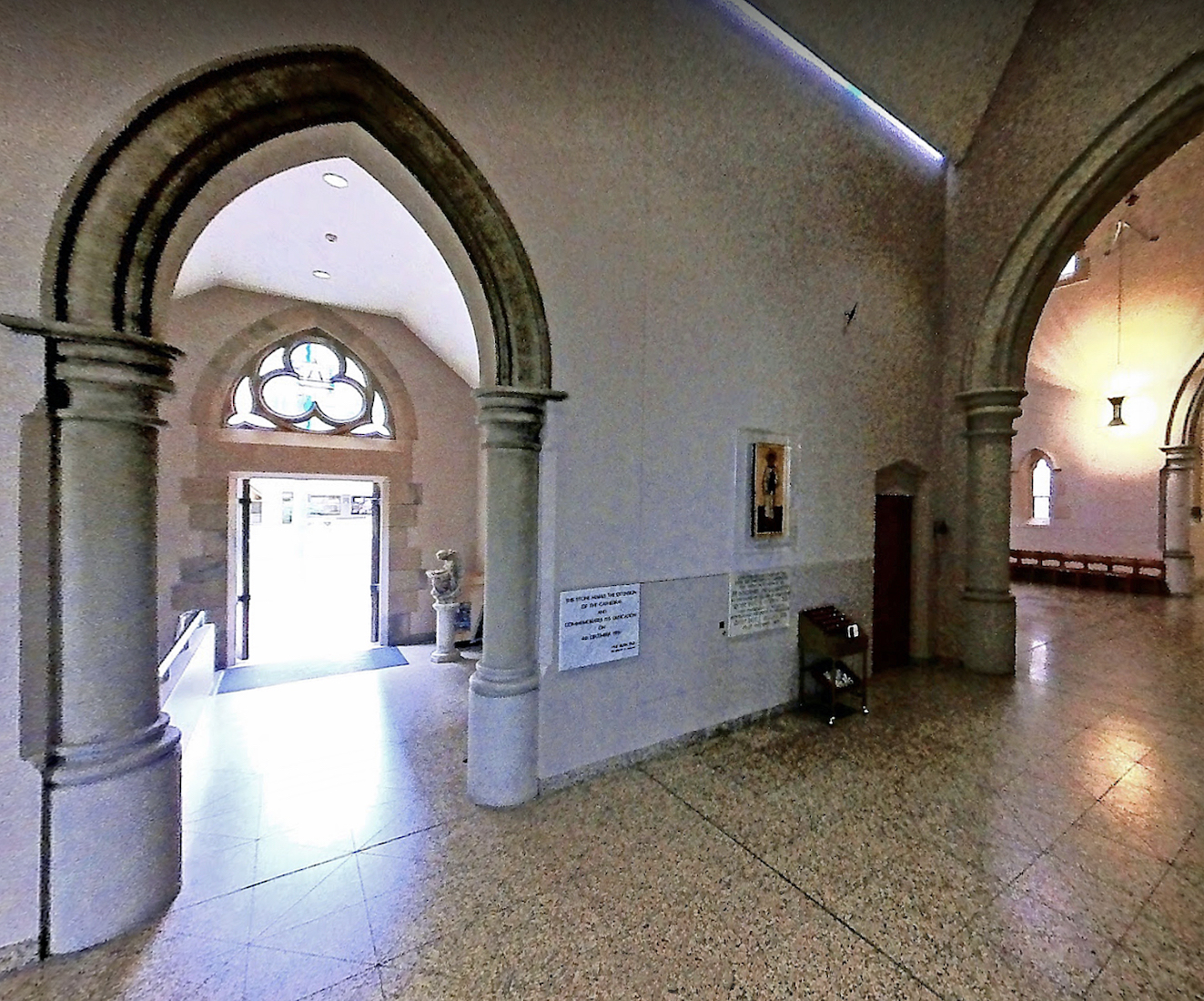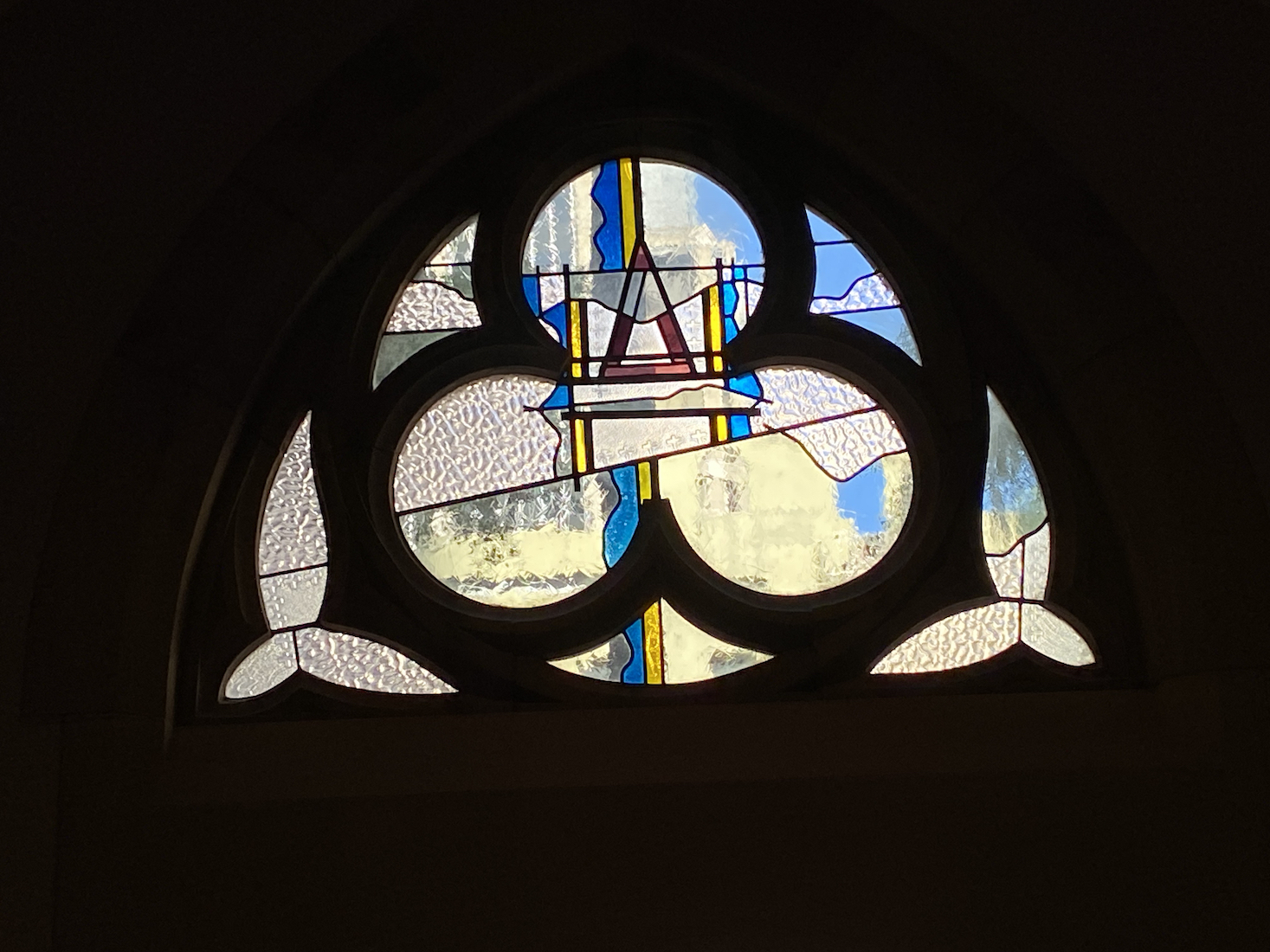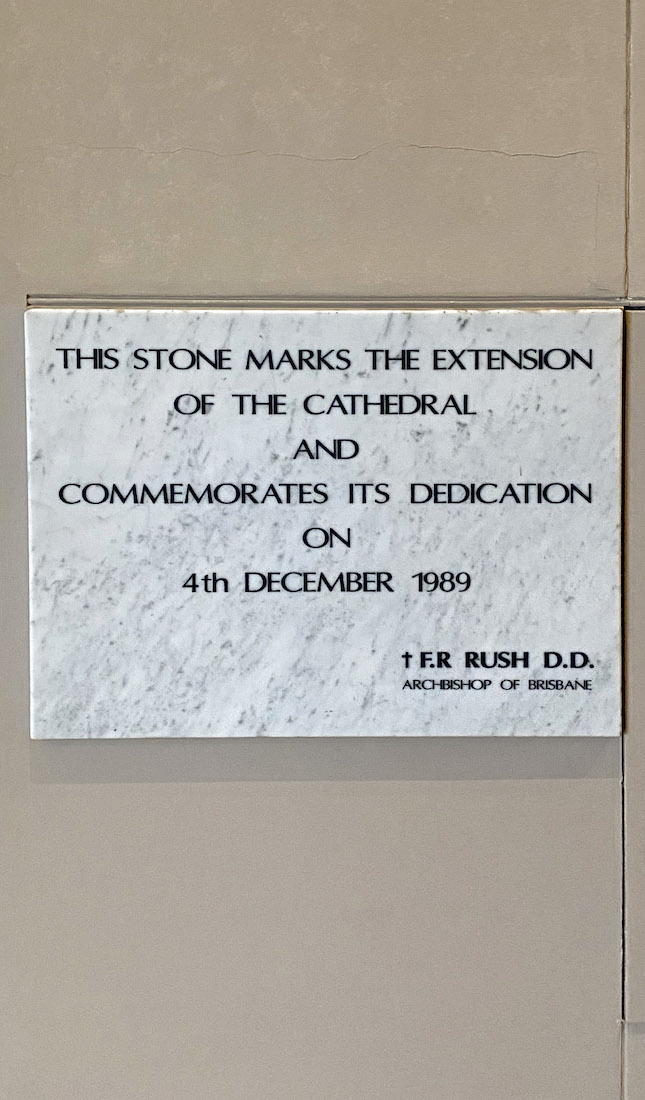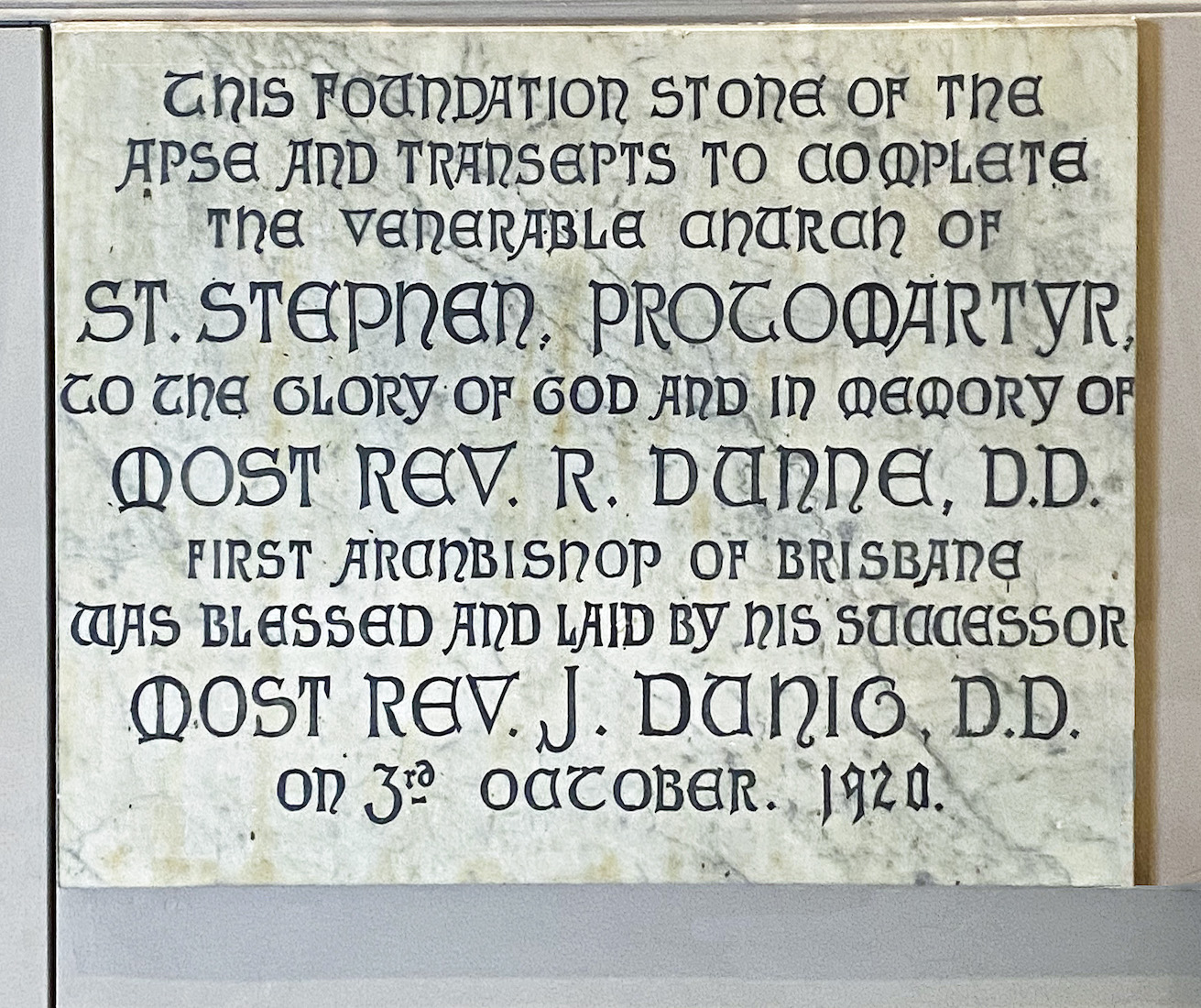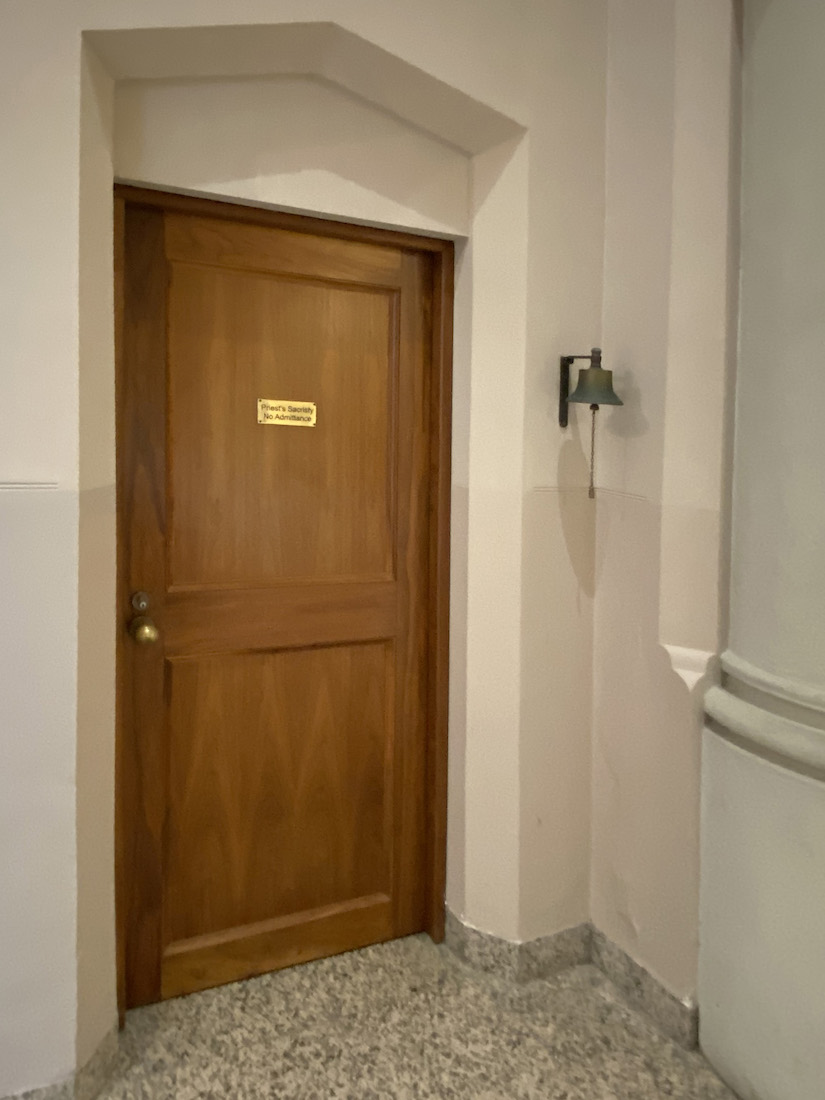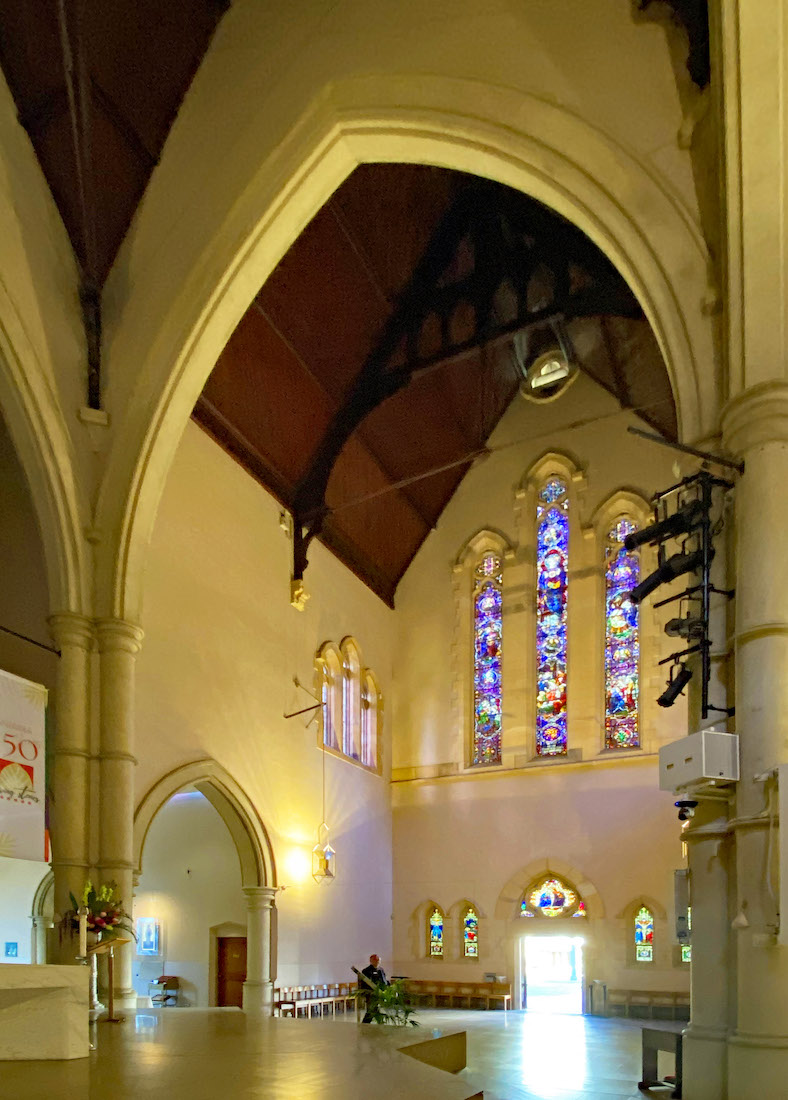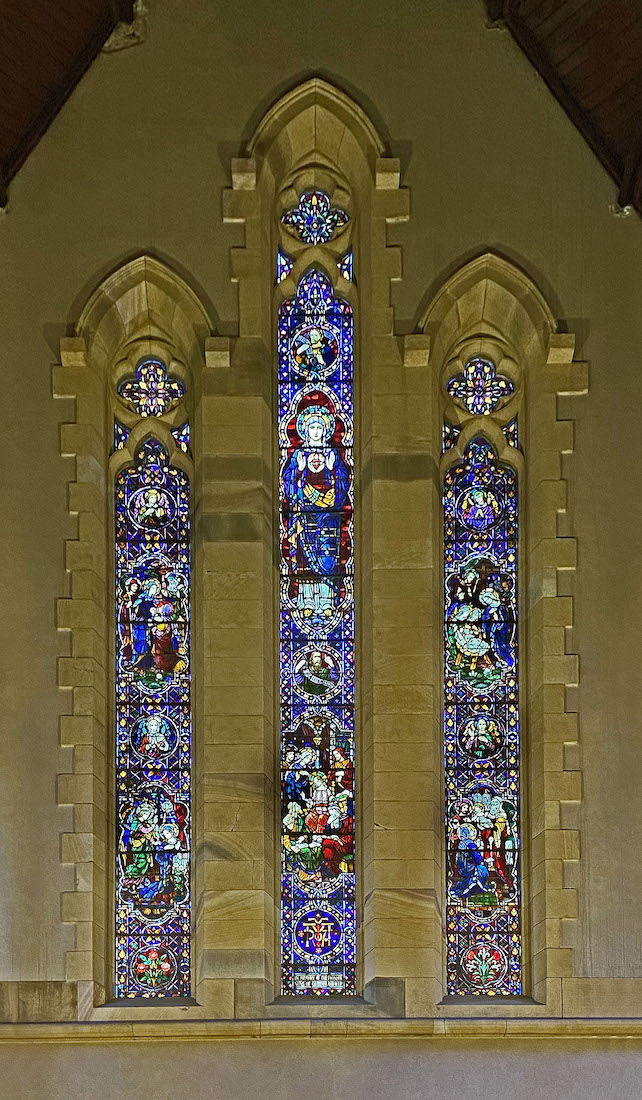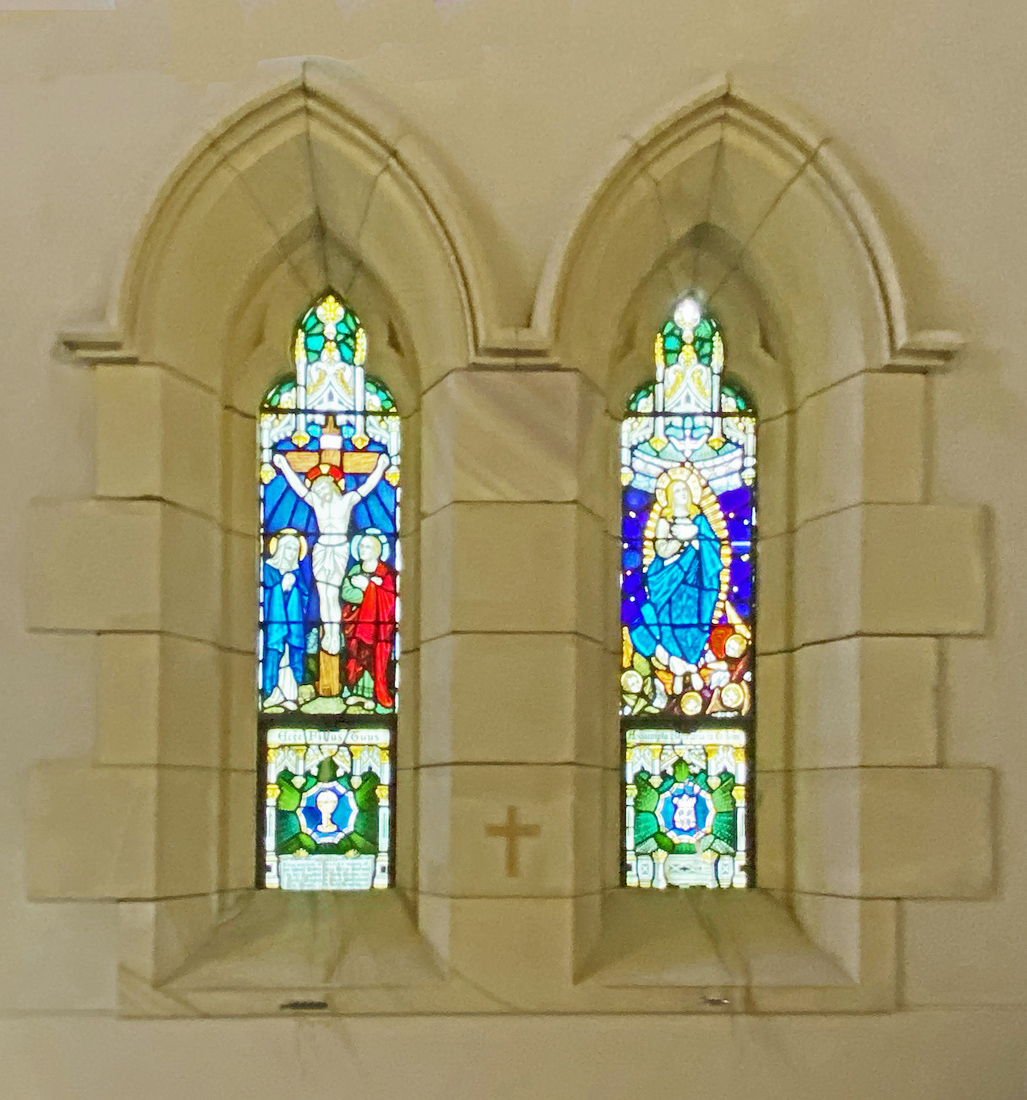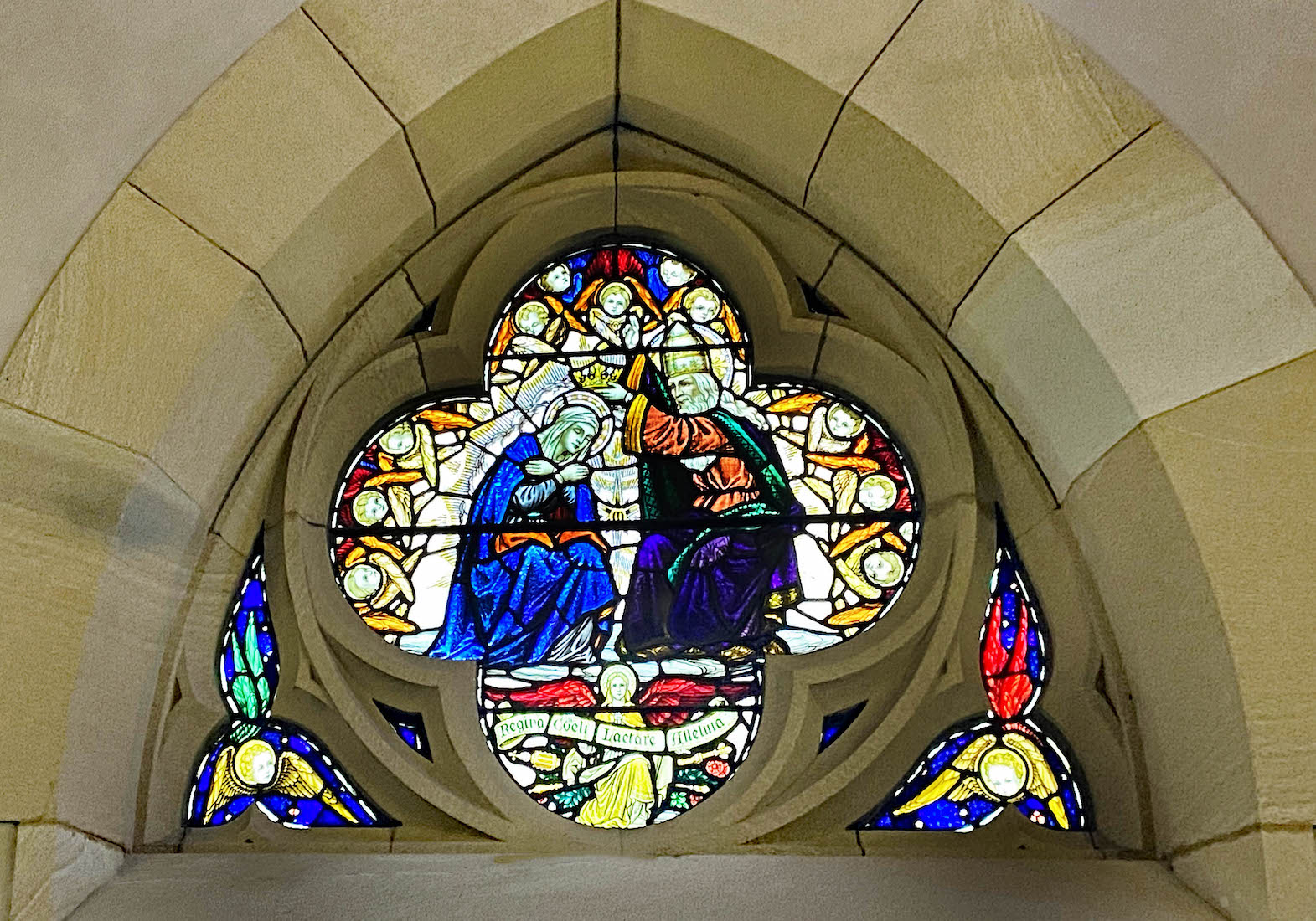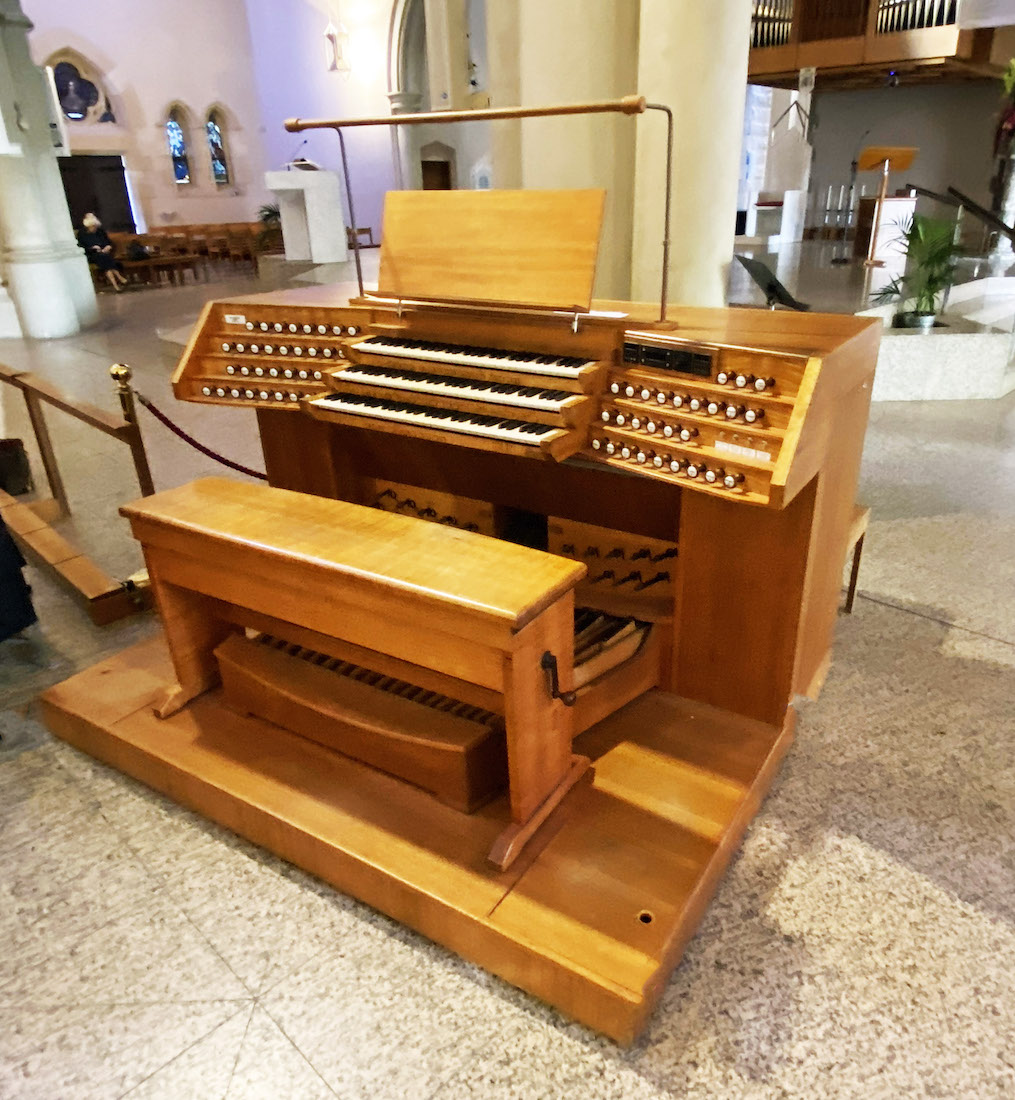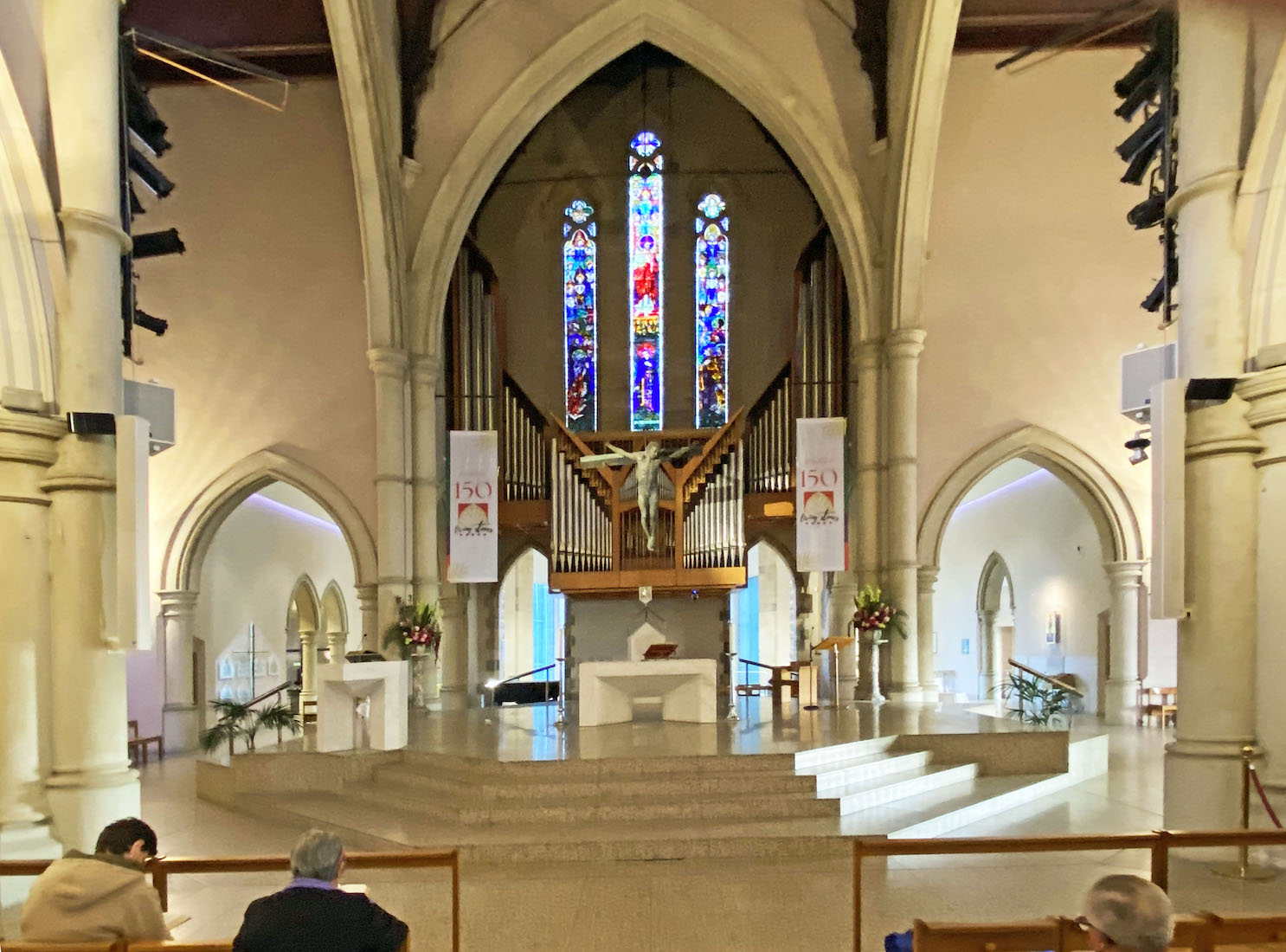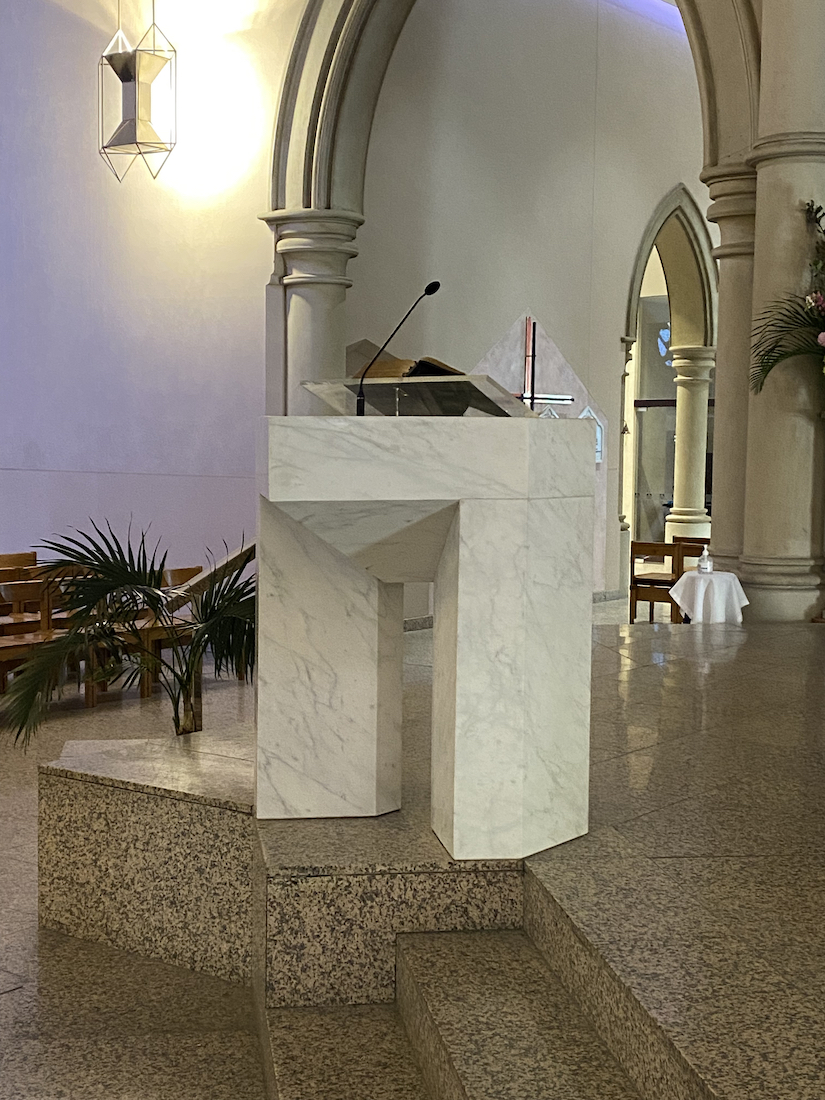61. CHAPEL CRUCIFIX AND TABERNACLE
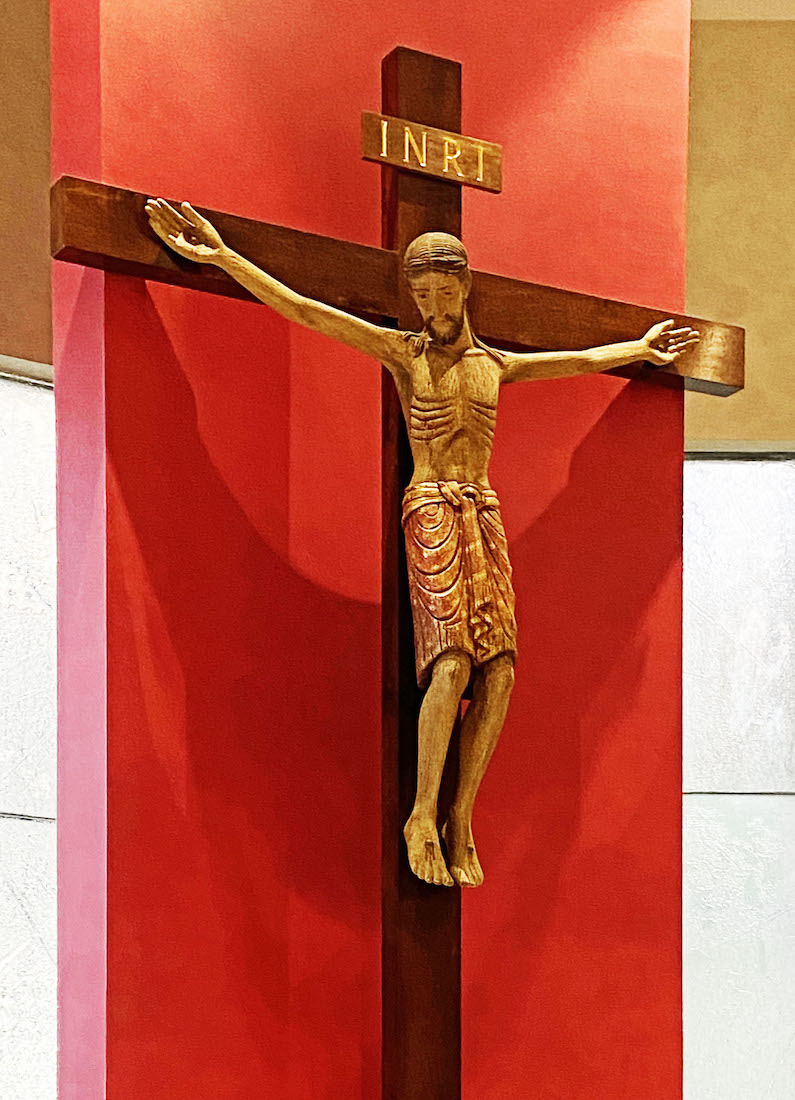
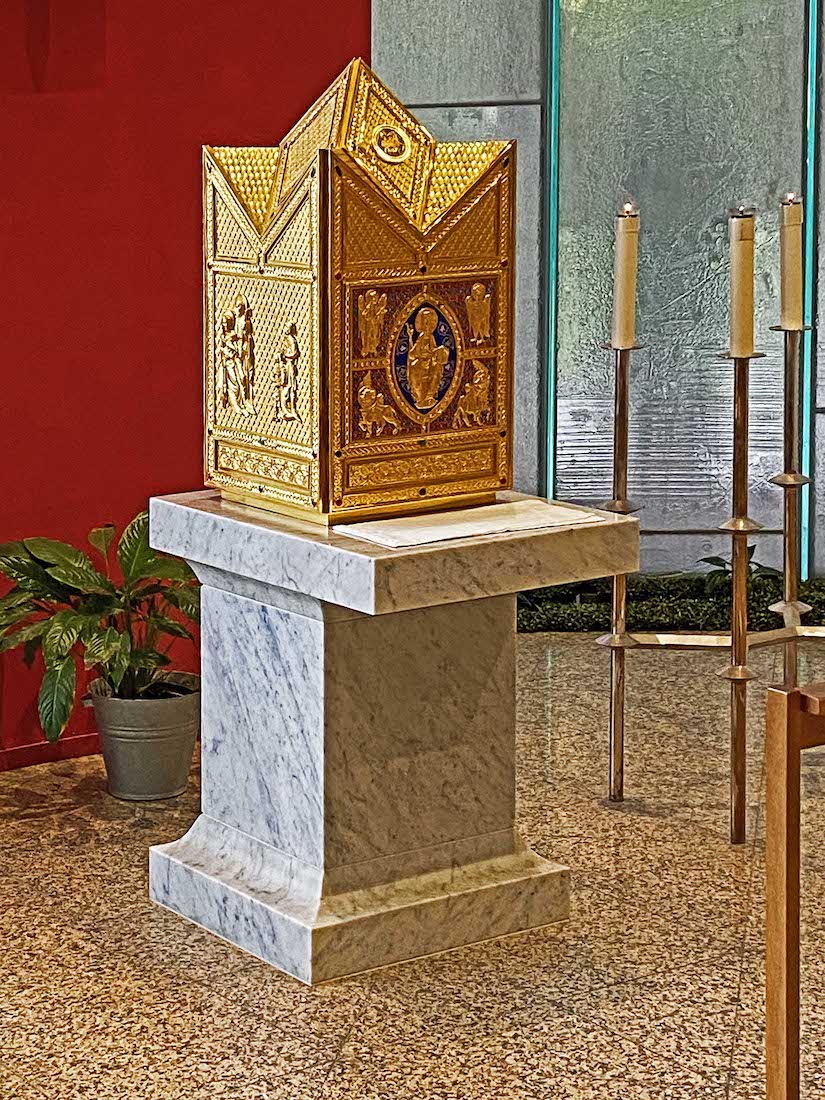
The central feature of the Blessed Sacrament Chapel is a large crucifix set against a plain red background. The cross and Christ figure are made of timber. ••• The tabernacle and monstrance are the work of gold and silversmith, Johannes Kuhman. Intimate in scale and simple in design they are crafted and engraved with crosses in silver and gold. The monstrance, used to display the consecrated bread for veneration, is placed on the tabernacle at times of more intense prayer and adoration. INDEX
62. CHAPEL GLASS
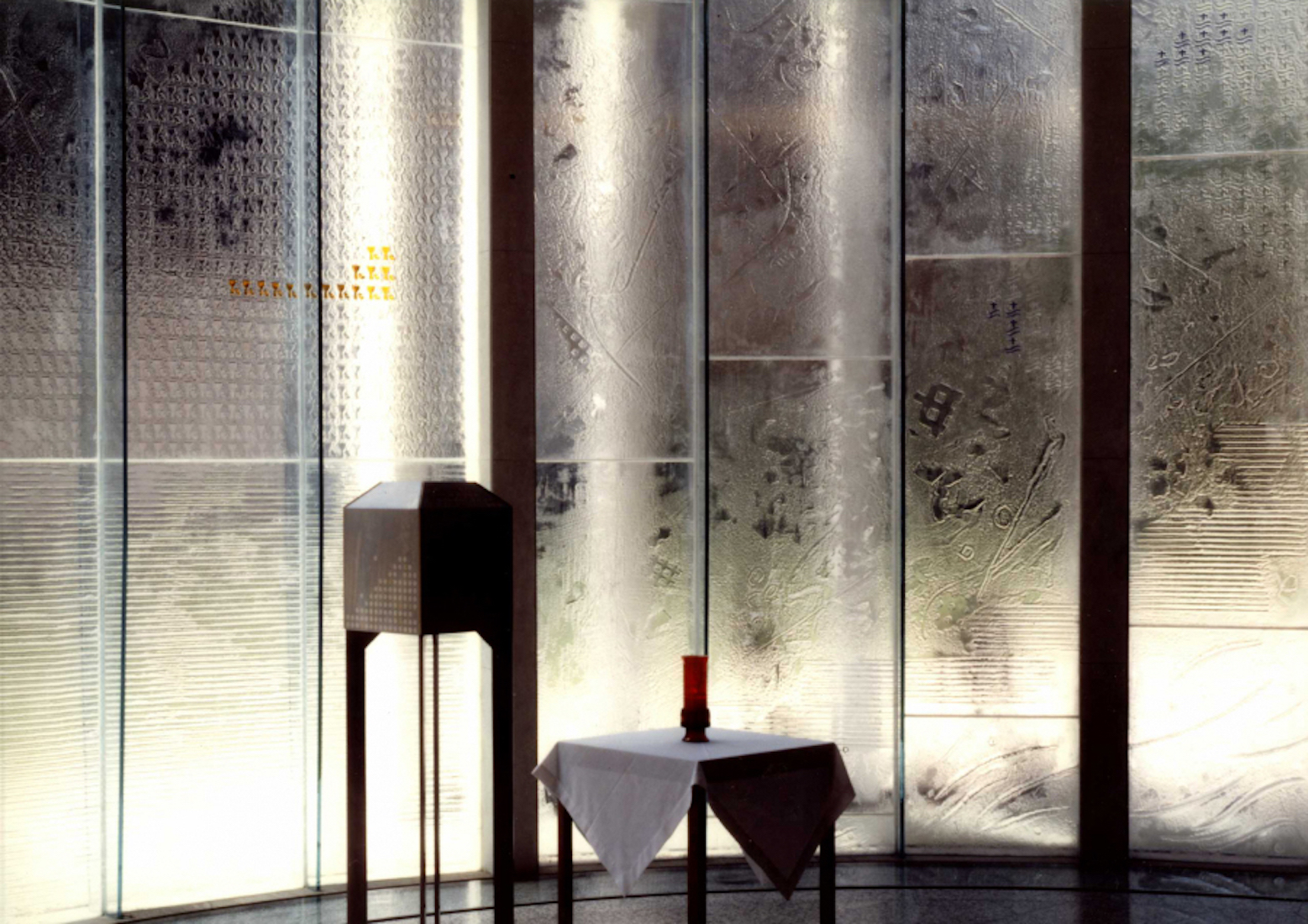
This is an older photo, but the glass is the same! The sacraments of initiation are symbolised in the magnificent curtain of glass which encloses the apse. The symbols of each sacrament are incorporated into the window (the cross and water of baptism on the right, the flame for confirmation on the left and the cup and bread of the eucharist in the centre behind the tabernacle). The window is a major work of internationally-known Sydney artist, Warren Langley.
63. CHAPEL SANCTUARY LAMP
Unusually, this Blessed Sacrament Chapel has two sanctuary lights. The light indicates that the tabernacle contains blessed Elements of the Eucharist. Normally the Elements would be blessed during a Sunday celebration. They are then available here for ministry to the sick during the week.
64. REAR OF BLESSED SACRAMENT CHAPEL
From our present position we can look across the rear of the Blessed Sacrament Chapel. To our immediate left there is a table bearing a monstrance (and other Eucharist items). On the central wall we see an interesting carved panel. And further off we can look along the aisle at the centre of the Reconciliation Chapel to the North door we have already mentioned.
65. LAST SUPPER
On closer inspection we find that the carved panel is the front panel of the old Cathedral altar, now located on the opposite side of the wall to where the altar once stood. The central image is that of the Emmaus encounter with the risen Christ [Luke 24: 13-35]. Saints Peter and Paul feature to the left and right of the central scene.
66. EUCHARIST TABLES
The monstrance we noticed is seen here as part of the preparations for a forthcoming Eucharist service.
67. SOUTH OF THE BLESSED SACRAMENT CHAPEL
On the South side of the Blessed Sacrament Chapel there are number of items of note. Ahead of us is the unusual baptismal font, with a Paschal candle at left, and the second round window high above. On the wall at right is a framed document, and the doors to a niche containing the sacred oils.
68. BAPTISMAL FONT
The water in the baptismal font flows from a smaller font where infants will normally be immersed into a lower pool in which adults will kneel as water is poured over them. One image used in Christian literature to describe the meaning of baptism is that of the Church as mother who, through the waters of the font, gives birth to a new Christian. This has been stunningly expressed in Carrara marble by sculptor, Peter Schipperheyn. The new-born child symbolises the new Christian emerging from the waters of the font to become part of the family of the Church. The spiral, a form picked up in the font itself, represents the baptismal cycle of death and rebirth. Inscribed on the floor near the font is a verse from the C 5th poem of Pope Sixtus III developing the baptismal theme of the church as mother.
69. SOUTH ROUND WINDOW AND PASCHAL CANDLE
The first round window is centred on the Crucifixion; this window on the Resurrection of Christ. There are angels in the corners, separated by lilies, and there is some sort of logo in the centre. ••• The paschal candle is the work of silversmith, Hendrik Forster, who also made the sanctuary candelabra. The paschal candle pictures Jesus as the Light of the world, and has prominence particularly during the Easter season.
70. COVENANT AND OILS
The framed document on the South wall is a Covenant between the Roman Catholic and Anglican communities. A similar document can be found in St John’s Cathedral, Brisbane. ••• The doors to the holy oils cabinet were made by Warren Langley. The cabinet contains Chrism, Oil of the Sick and Oil of Catechumens.
71. SOUTH DOORWAY
There is a South exit door on this side of the Cathedral, as we have observed from the exterior. This door too has an abstract stained glass window above it. ••• On the wall between this exit and the South transept there are two plaques, an icon, and a sacristy door.
72. FOUNDATION STONES
At left is a memorial tablet marking the extension of the Cathedral and its dedication in 1989. ••• Them closer to the South transept we find the 1920 foundation stone commemorating the erection of the apse and transepts. Robert Dunne succeeded Bishop Quinn who died in 1881, and became the first Archbishop of Brisbane in 1887.
73. ICON, SACRISTY DOOR
Above the second plaque is an icon of St Stephen. Stephen is traditionally venerated as the protomartyr or first martyr of Christianity. He is mentioned and dies within two chapters of the Book of Acts (Acts 6,7).
75. SOUTH TRANSEPT WINDOW
The three tall slender panels of the South transept windows ... . This window is similar to that of the North transept, but here the theme is Mary. At top centre there is an image of the glorified Mary, and other events in her life are depicted in other parts of the window. Examples are The Annunciation, the Visitation, the Nativity and the Presentation.
76. LANCET WINDOWS
The four lancet windows in the South wall of the transept feature scenes involving Mary, including the Crucifixion of Christ and the Assumption of Mary at right.
77. ABOVE THE TRANSEPT DOOR
Above the South Transept door is a small stained glass depiction of God crowning Mary as Queen of Heaven. Inscribed on the scroll below the figures is: “Regina coeli laetare, Alleluia” (Queen of Heaven, rejoice, alleluia). i.e. the first line of the “Regina Coeli” – an ancient anthem to the Virgin commonly sung during Easter. The text is: ‘Queen of Heaven, rejoice, alleluia. For He whom you were worthy to bear, alleluia. Has risen, as He said, alleluia.’ The Regina Coeli is traditionally ascribed to St Gregory. All of the transept windows were produced in Brisbane and were installed, blessed and dedicated in 1941.
78. ORGAN CONSOLE
The organ console is to the South side of the nave, close to the sanctuary platform. The ‘Jubilee Pipe Organ’ was inaugurated on 28 October 2000 and blessed on 29 October. It is named after the Year of the Great Jubilee 2000. The organ has three manuals with 44 stops in four divisions, Great, Positiv, Swell and Pedal.
79. SANCTUARY
The sanctuary in the midst of the assembly is designed to give the sense of people gathered around the altar in a corporate act of worship. The action of the liturgy is not confined to the sanctuary: the whole Cathedral is the place where worship is offered to God by the Church. The key elements in the sanctuary are the bishop's chair (cathedra), ambo and altar. They were designed by architect, Robin Gibson, and crafted in Carrara marble by Peter Schipperheyn.
80. AMBO
Non-Catholic Churches often have a lectern for Bible reading and a pulpit for proclaiming the message. Catholic churches (cathedrals) frequently have an ambo which serves both purposes. In St Stephen’s the ambo, cathedra and altar share many common design features.


